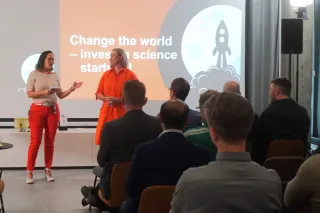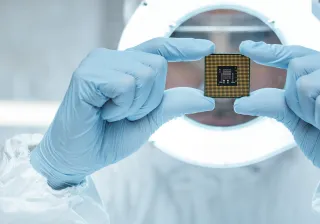With the explosion in popularity of wearable activity trackers in recent years, people have access to a huge variety of stats and analysis tools to help them set personal goals and track their performance. But there’s a problem: many of these devices are way off the mark when it comes to accuracy. The answer to this challenge lies in the algorithms that form the backbone of the software in these devices; improve the number crunching and you can provide users with a smart solution that not only accurately tracks activity, but also learns as it goes along.
The wearables market has seen massive growth in recent years as people seek ways to gather more and more data on the sports activities they participate in and smarter ways to analyse their performance and track progress towards personal goals. According to the International Data Corporation, the global wearables market is expected to grow from 113.2 million shipments in 2017 to 222.3 million in 2021. It’s therefore no surprise that big names are all in on the action, including Apple, Samsung, Fitbit, and Garmin, to name just a few.
The range of devices available to the average consumer today covers everything from basic step trackers and other single-purpose devices to smart watches, as well as high-end, specialized wearables aimed at hardcore sports enthusiasts and elite athletes. Inside these compact devices a wealth of technology is used to monitor movements and gather data, including sophisticated sensors and complex software powered by smart algorithms used to crunch the numbers.
A numbers game that doesn’t add up
The problem with many of today’s commercially available wearable activity trackers is that the algorithms they use to process the activity data are based on general population data. While you might be able to enter a limited set of parameters such as your height, weight, and age, there’s often no opportunity to enter parameters that are highly personal to you, such as gait pattern, which also varies according to the shoes you are wearing and the type of ground you’re walking or running on.
And it’s this sort of data that makes a real difference when it comes to presenting accurate results for your activity.
The issue until now has been one of size – the more accurate the algorithm, the more ‘space’, or computing power, it needs. “Device manufacturers have been faced with a trade-off between memory size, processing requirements, and performance in the past,” says Jani Mäntyjärvi, Principal Scientist at VTT. “It’s a matter of the design requirements, tailoring the approach to your needs. You have to consider the activities you want to recognize and define, the number of parameters – in other words the size of the algorithm – and the performance level you’re looking for.”
“Many of the commercially available wearables just don’t have the accuracy you need to give a true picture of the calories you’re burning or the movements you’re making,” says Mäntyjärvi. “They can be as much as 40% off, and even the best devices currently available probably have an error margin of somewhere in the region of 15%. So while you might think you’ve nailed that calorie target on your run or cycle ride, the reality is probably quite different. Accuracy of close to 100% is possible, but you’d need tens of thousands of parameters and a lot more computing power than today’s wearable devices can pack in.”
Digging deep with cutting-edge algorithms
What’s needed is a deeply intelligent algorithm that can build up a picture of your movements based on some simple activity prompts and then use this to generate much more accurate results.
VTT has already taken significant steps towards solving the size vs. performance problem with a new approach based on deep neural networks. The Deep Activity algorithm developed at VTT can be partly based on general population data and integrate machine learning to create a personalized movement model. It can also start completely from scratch, learning as it goes along without using any general data as a basis.
“With existing algorithms the device makes a lot of assumptions based on what applies to the average person, whereas with Deep Activity it’s like starting with a blank slate,” says Mäntyjärvi. “The algorithm ‘learns’ your personal movement patterns in a matter of just a few minutes, and gets smarter all the time. Some patterns can even be recognized without any input from the user at all.”
Deep Activity overcomes another challenge that existing algorithms have also struggled with: recognizing complex activities that involve several different kinds of movement. Current solutions are fine when it comes to repetitive periodic activities like walking, running, or cycling; Deep Activity takes things a step further with the ability to combine several lower-level movements in order to recognize the complex, composite activity patterns seen in sports such as soccer or basketball, where the player may be jumping, sprinting, and turning.
But it’s not only sports activities that can benefit from these new algorithms. Another important, and increasingly lucrative, application area is the healthcare sector. In post-operative rehabilitation, for example, a device could accurately track the rate of improvement in a patient’s range of movements and alert doctors if things are progressing slower than expected. Insurance companies are understandably also becoming more and more interested in personal activity trackers, for example, as an input to the risk assessment process for coverage.
A future where accuracy matters, but size doesn’t
Looking to the future, accuracy is going to be the driving force for a long time to come. “From the point of view of activity tracking and also health monitoring, more accurate detection or recognition is going to be critical. If wearables don’t measure up in terms of accuracy, or up their game in terms of context recognition, the products won’t have a very long shelf life,” says Mäntyjärvi. “In order to bring new services to market that have real value for the user, companies have to improve the quality of their data.”
Jani Mäntyjärvi sees wearables for tracking activity – whether for sport or health-on-the-move related applications – taking huge leaps forward in the near future. “Technologies like augmented and mixed reality will open up a whole new world of possibilities in the coming years. In a year or two from now, pretty much every activity-tracking application we download to our smartphone or wearable will include some form of AI element,” he points out.
“And then there are advances like 5G to consider, which will change the game in terms of the data processing pipeline. Higher bandwidths and lower latencies will open up greater possibilities for more processing of activity data to take place in the cloud rather than on the device itself – meaning algorithm space is no longer an issue. We are currently researching this type of split situation, where simple activities are recognized in the device and more complex ones at the edges of, or in, the cloud. Once 5G is mature enough to roll out globally we will be able to offer so much more in terms of solution complexity and recognition accuracy.”




